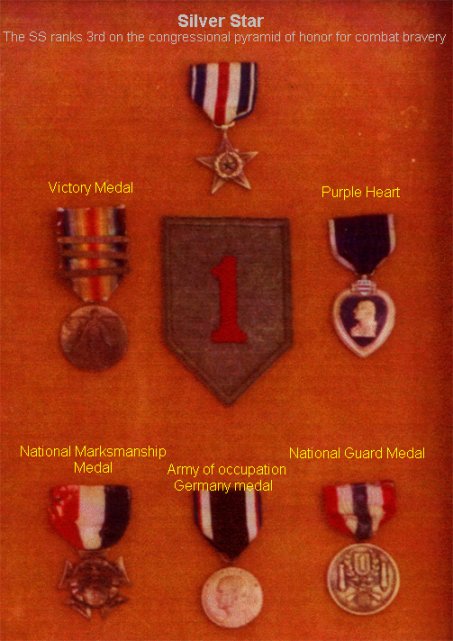
|
DIARY OF A SHAVETAIL |
SECOND LIEUTENANT
WILLIAM A. MANSFIELD
A Member of the American
Expeditionary Force in World War 1
St.Mihiel : Meuse - Argonne offensive
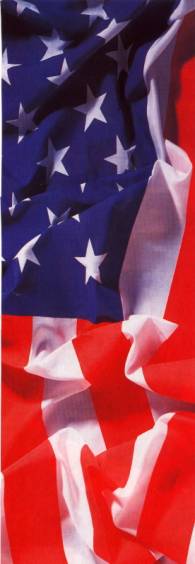
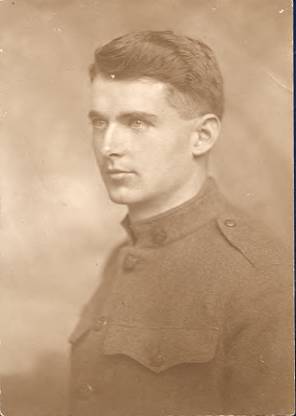
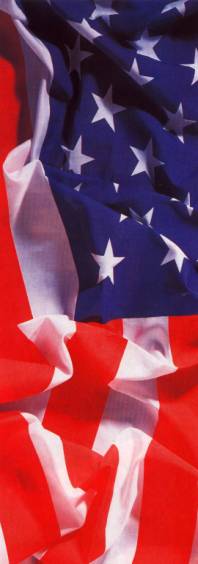
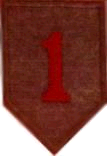
Medals attained throughout his career

Piece of undergarment worn when wounded
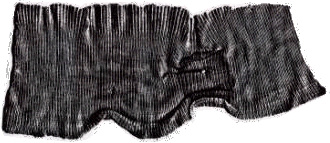
1893 . WILLIAM A.MANSFIELD 1986 .
Born: Rochester.NY. 13th February
1893
Died: Jacksonville,Fl. 21st September 1986.
Army No: 0.1001833742
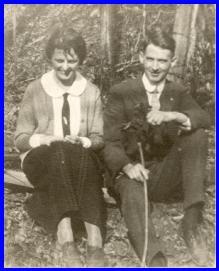
William Mansfield was married to my father's sister Doris Tallis
They were married at Elmira,
New York State on 8th August 1924
 His
career started with the National Guard,
His
career started with the National Guard,
In Elmira, New York.
He was stationed on the Mexican Border during the
troubles of 1916.
He then went out to France with the 1st
Army, 26th Infantry.
In 1918, he fought at St. Mihiel and in the Argonne Offensive
where he was wounded.
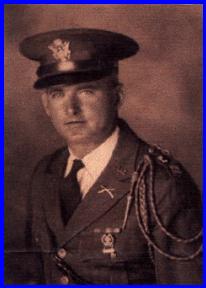
In the WWII, now a Major
he was stationed in Italy and Greece.
He retired from the Army having reached
the Rank of Lt. Colonel.
The following pages of this document
are his observations during WWI taken from his letters & diaries written at the time.
|
|
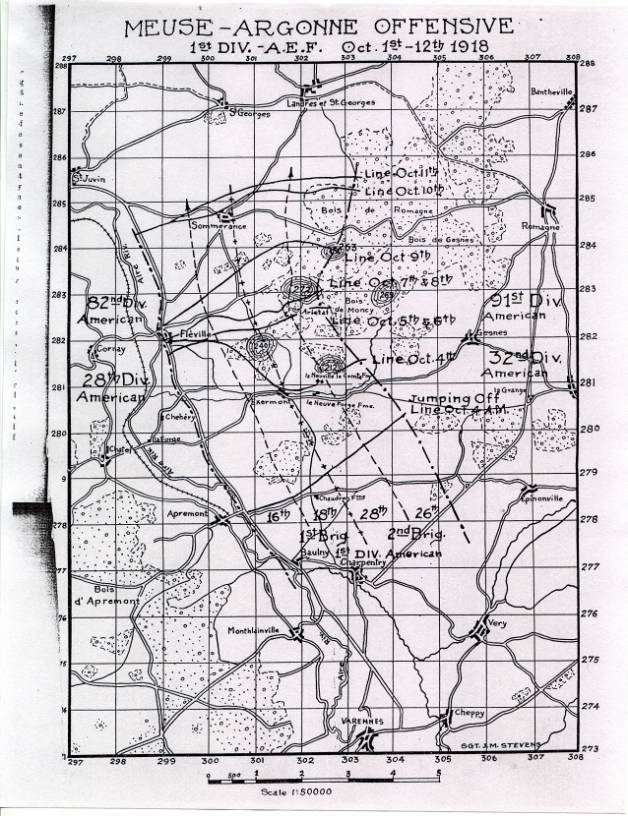
WORLD WAR I
| 5.31.1918 | Landed at Brest, quaint old town. | ||
| 5.31.1918 | Hiked to Portenezen - two miles from Brest. | ||
| 6.6 1918 | Paraded in Rennes. | ||
| 6.8.1918 | Arrived in Nogelles then hiked onto Norvian. | ||
| 6.9.1918 | Arrived in Gauchy can hear the guns in the battle line. | ||
| 6.10.1918 | Gauchy. | ||
| 6.16.1918 | Big Air Raid on Cetteville. | ||
| 6.17.1918 | Left Gauchy arrived St.Blimont after hike of 22 Miles passed through town of Cetteville, saw some of the Damage done. | ||
| 6.19.1918 | St.Blimont. | ||
| 6.21.1918 | Left St Blimont, arrived in Buigny and hiked onto Hautrillers, hiked back to Buigny being in the wrong Territory. | ||
| 6.22.1918 | Left Buigny in carrier and arrived in Biaencourt. | ||
| 6.25.1918 | Found pack at St.Ligea. | ||
| 7.2.1918 | Left Scaudrecourt arrived St.Omer. | ||
| 7.3.1918 | Arrived Bussychare lots of aerial action activity 9 out of 10 are French - July 4th celebrations. Depressed on seeing enemy aeroplanes. | ||
| 7.5.1918 | Left Brese arrived Fenerzille. | ||
| 7.7.1918 | Hiked through Gassel, France into Heendare, Belguim, in camp near Watou. | ||
| 7.8.1918 | St.Varney. | ||
| 7.9.1918 |
|
||
| 7.10.1918 | Only 7 miles from front line. | ||
| 7.17.1918 | Camped near steelworks, Belguim. | ||
| 7.19.1918 | Wore 2nd Lts. bar and pips from the Headquarters of 1st Army, stopped off in Paris, Church of the Madelaine bombed by Big Bertha shell. Digging all around it, cannot carry diary any further. so into the Church locker it goes. | ||
| 9.12.1918 | At the Battle of St.Mihiel. | ||
| 10.3.1918 | Outside Exermont, Muese- Argonne Offensive. | ||
10.4.1918 |
Attack : wounded later in the day. | ||
10.11.1918 |
In Hospital in Contrexeville, France not to far from Nancy. (Shot through the leg). |
Note: Roberta, Uncle Bill's daughter has the piece
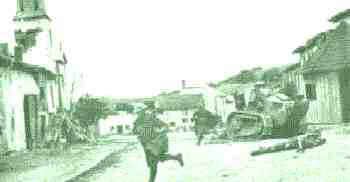
" Doughboys under fire in the Village of Exermont "
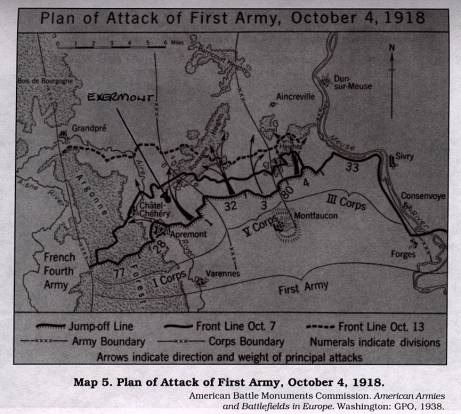
OCTOBER 4th , 1918 2:00 am.
Lt. M inspecting platoon for extra ammunition, gives order to Sgt. 0 . that he has been appointed to an Officer's Training School and to report immediately to Regimental Headquarters. Sgt. 0 . instantly disappears from foxhole, gas alarm inspection, continues with gas mask covering faces.
Enemy artillery have been firing all night, but about 50 yds. to our rear the shells are falling. Ahead about 500 yds., the 1st Battalion under Major L., ready as assault Battalion to jump off at 4:55 am, or in about two hours. Capt .Y. is in a tree branch covered foxhole just beyond the edge of the unimproved road to our front about 20 yds. The chug of motors can be heard. Yes, here are two French Renault tanks. One turns off the road near Capt. Y's foxhole The other goes further down the road.
Intermittent shelling continues. 3:30 am near noiseless. A double pair of horses hauling a French seventy-five manned by French gunners can be observed.
They turn off the road toward the assault Battalion and on the opposite side Capt. Y's foxhole from where the tanks turned a short while ago. Everything is on schedule so far. It won't be long now before our barrage is scheduled to open upon the enemy line.
The additional weapons certainly add improvement to our superior morale. It was only yesterday afternoon that we had observed an Allied Fleet of planes numbering more than 100 in a large group fly over the enemy line and harass the enemy reserves which we hoped would be late in arriving to help their brothers. Soon now to feel the "let's go" cry of so many of our Doughboys. Inspection finished and Lt M. reported to Capt Y. that his platoon was ready for action. In the meantime, the gas alarm had been changed to all clear and gas masks were removed and kept at the alert.
Capt Y. directed Lt M. to keep on the end of the line while we were going through a gap in the wire in front of Capt Y's foxhole.
We were about ready to go through, as our barrage would be letting go shortly, and we wanted to be on the other side of the wire when the enemy barrage fell. This was a bold stroke which saved the lives of many of us. At intervals, we could see all along the enemy line, the 3 green star shells floating upward and disappearing, meaning all was safe in their front. Shortly, from those same locations, would go the red star shells, signalling attack and calling for a barrage in front of their trenches. It was nearly 4:00 am and a signal from Capt. Y. indicated squad columns and the platoon climbing from their foxholes, which had been home for 5 days, formed and moved forward. We crossed the road and passed the C.P. of Capt Y.
Sitting on their horses and gun caisson were the French gun crew, who were to follow our support Battalion and blast enemy pill boxes and nests when discovered. Capt Y. was in the lead going through the wire with Company E following. Lt M. on the rear end, observed all go through this prepared passage as daylight was fast approaching.
Our own artillery had been unusually silent since midnight but one could hear enemy machine guns popping-off intermittently directly to our front. As Lt M's. platoon formed again, the heavens opened up and the roar was deafening. Brilliant blasts of fire, smoke and dust rose in clouds just a few hundred yards ahead. Promptly and right on schedule, our own artillery was laying down a terrific barrage. Smiles could be distinguished underneath steel helmets as we were aware of the uncomfortable position the enemy was in right now.
Silent, we waited, lying flat, for the schedule lifting of the barrage and jump-off of the 1st Battalion. By this time, the enemy, aware of something unusual, began sending red star shells up. This reminded one of the pretty coloured roman candles and 4th of July fireworks.
Daylight was on us as zero hour came along with some enemy shells which were poorly aimed. The enemy barrage came down but most of it dropped near our five day homes. Nobody was in them now. Remember Swichprey! Roofless homes, but good cellars. Our five-day homes were hand fashioned, about four feet deep, within whispering distance of good neighbours, extremely comfortable during the strafing of flying circuses, minor artillery fire and sunshine days.
Capt. Y. gave the signal to move forward and in the same formation as ours. This picture was indelibly printed on Lt.M's mind. As far as vision permitted right and left, a wave of khaki clothed men with bayonets at the " high carry " were moving forward as on manoeuvres. Lt. M. picked up a discarded shovel and during the rest of the exciting day, this shovel with its steel flat piece was used the next few hours as a face shield against which resounded shell fragments, dirt and rock splinters, and finally as a means of getting one's body from the earth's surface to a depth of three feet and safety from enemy snipers.
This last act was accomplished by lying flat on one's back, digging with a side arm movement, pretending the last snipers shot was good, then suddenly digging like hell until another zing which signalled you were being observed through a telescopic sight.
The First Battalion had taken objectives as scheduled and we had leap-frogged them about 11:00 am. Our Battalion was to take the third and fourth day objective. Ever forward! To the best of Lt M's knowledge, the Frenchmen, their guns and horses never lived after the enemy barrage dropped. The Tanks had been following through, they had not been needed. After leap-frogging the 1st Battalion, it was discovered that fire in our direction was coming from the front of both obliques.
Orders came to halt, which was on a reverse slope of a small hill where the Battalion was reformed.
The fire in front was withering. At this juncture, the first tank rumbled over and started down the gentle slope. It lasted two minutes. A direct hit by enemy artillery had made it spin round and halt. Another tank rumbled up and fared no better than its brother except getting slightly nearer the enemy positions. The BT. Commander, Capt W., in order to better observe where the enemy fire was coming from, ran to the first tank. He died, mortally wounded.
Capt Y., the senior Capt, with a Major's commission in his pocket, now assumed command. He knew he was senior to Capt W. but refrained from making the fact known, A real man, officer and Gentleman was Capt Y.
Now, for the first time he lead his battalion and was addressed as Major Y. The Major, with map on his knees, oriented, and endeavoured to locate on the map the possible location of enemy machine gun nests and artillery positions for communicating the locations to our own artillery. Major Y. called for a thirty-seven mm which had been attached to our Company. Quickly they came, set their gun, aimed and fired where the Major directed. Another picture indelibly printed on Lt M's memory, is Major Y. kneeling, map on knee, tobacco in large amount in cheek, bullets and shells falling in proximity, giving orders to gunner where to direct fire. About 2:00 pm now,the Major decides to assault the MG nests directly in front at the edge of a wood about 1000 yds from our position. The verbal order was given, directing E & F Companies assault with G in support. 3:00 pm - zero hour. Lt. B assumed command of E Company and ordered the following procedure:
Platoons 1 & 3 assault, 2 support direction of attack and time.
Lt M. commanded 3rd Platoon. Again, check was made of Platoon for ammunition. Not too many men in Lt M's Platoon now. Waiting for zero hour again. Our Battalion seemed like a spearhead for the Regiment.
During the next hour some of the men from their positions on the reverse slope smoked their cigarettes and would not be present at roll call tomorrow morning.
3:00 pm. forward over the crest, down the slope, running men falling, shells bursting until a creek was to be crossed. Convenient bridge crossing were there and Lt M. shouted not to get near those enemy made crossing which were criss-crossed with enemy machine gun fire. Half of Lt M's platoon reached the creek and after reforming, began a fire on the enemy positions within 100 yds of us. Luckily, one rifle grenadier survived and reached the creek, with two rifles grenades. He made direct hits at the target and firing became less violent from that position after his cool, well-directed shots. Lt. M. in the creek, last remembers a platoon of F Company on the right charge with bayonets in the sector front and the enemy fire became less and less severe. Funny do not hear artillery fire. A Frenchman with a Red Cross insignia, wheels rumbling, reveals the fact that Lt. M. is riding in a French hospital train and is on a trip to " Blighty ".
-------------------------------------------------------------------------------------------------------

BASE CAMP HOSPITAL: CONTREXEVILLE
.
Having been here since 6th October with three room mates, one 1st Lieutenant Medical Corps, appendix operation; Capt Harrigan, 77th
New York Division with a shattered arm in a sling, whose wife, Nella
Sang with the Metropolitan Opera; and Second Lieutenant Maverick,
San Antonio, Texas, who lay on his stomach, both arms hanging over his movable bed, a terribly long gash on his back, a member of the 16th Infantry, First Division.
His rapid fire conversation with us mostly about Texas. He was evacuated to the United States after a week at Base 18.
It was such a contrast, three warm meals a day, sleeping between sheets to the proceeding months of foxhole living, the uncomfortable periods of wearing a gas mask, deafening shell explosions, cootie hunting and rationed water.
The Armistice, now more than five weeks old, was operating as planned. The Army now filled with replacements was on the march through Luxembourg and Germany to its assigned Bridgehead over the Rhine at Coblenz, the Headquarters of the American Army of occupation. The British Army Headquarters on our left was at Cologne with the French Army at Wiesbaden, with a 20 mile neutral zone extending beyond the bridgeheads.
I had been marked for duty, there were many here still receiving treatment for wounds and gas. Vichy, a worldwide health resort was not far away from the hospital. It made a long day shorter by hiking over there. Outside news of the world was negligible.
At the railway station in CONTREXEVILLE, not far from the hospital, was a bulletin board, daily news from all the battlefronts was written in
French in longhand, writing labelled " Telegram vosges" 16th October 1918.
Late in that evening I had hobbled to the station and removed the paper. My efforts to master the French language were enhanced. I have that " communiqué" framed and among my souvenirs. Posted on the bulletin board, an order from General headquarters " all patients marked for duty were to be returned to the United States". My hopes
of returning to my regiment received a real setback.
The Hospital Commanding Officer had just left for a ten day leave.
A Lieutenant Colonel was now in charge. Pretending I had not noticed the recent order, I went to his office with a request to return to my regiment. Within the next ten minutes I possessed an order to report to the Commanding Officer of the First Infantry Division then MONTABAUER, Germany. I wondered how many of my platoon had survived my absence. Some would be missing.
Leaving next day, December 24th arrived in NANCY. Found I could not get a train for Luxembourg until 26th December enroute to Coblenz.
The MPs stamped my Travel Orders on arriving at the station.
Tomorrow Christmas day, I would eat Christmas dinner alone. The only time in my life.
Leaving NANCY 26th December, I arrived in Luxembourg. Got a taxi for the Hotel "Continental", saw a Pierce-Arrow car in front and thought some American executive was a guest, checking in. I inquired of the desk clerk who owned it. He replied " Princess Charlotte is entertaining". Spent the remainder of the day wandering around the area. I do not remember whether the MPs were there. Left for Coblenz next morning.
not permit me to take off Arriving in Coblenz, found that the First Division Headquarters reporting to the Adjutant. When he looked at my MP stamped order exclaimed "How the hell did you get here? We have Captains and Majors trying to get here!" He gave me an order to report to Commanding Officer, 26th Infantry and furnished transportation to
NENTERSHAUSEN. Reported to Headquarters and found Colonel Teddy Roosevelt in command. He greeted me warmly. Our 2nd Battalion, On October 4th had leapfrogged his battalion after they had taken the first and second objectives in the day's battle. He assigned me to my "E" Company, 2nd Battalion.
HEILBERSHEID was Battalion Headquarters while HIEDERERBACH was a small town on the edge of neutral zone with one-track railroad passing through. At Company Headquarters found Captain Dorn in Command. He was a graduate of Cornell University (just 20 miles from my home in ELMIRA, NEW YORK ) and a resident of JAMESTOWN, NEW YORK.
A replacement Officer, one 1st Lieutenant and three 2nd Lieutenants all hiked from France to present location. I was extra. After being assigned quarters in a large bedroom in a private home, two other Lieutenants also had cots to sleep on, a dresser and two or three chairs. It was getting dark. I was ready to hit the hay. Candlelight revealed a candleholder made from candy box top that looked familiar to me. It was a top of one pound savour. One of the packages that Dad had sent long ago. Found 104 letters that had followed "E" Company for the past six months. The other packages had been emptied.
Letters were from friends and relatives. The one pound " Mansfield Nouvelle" was one of them. I was wearing a gold sleeve chevron s
above the cuff, right cuff wounded- left cuff six months overseas - thereafter another gold chevron for each six months service. I believe the chevrons and being an extra was the main reason for me to be selected for a thirty-day attachment to the Military Police in COBLENZ
And also my left leg was not quite 100%. COBLENZ was to be a leave area.
Captain Crofist was in Command of the MP's in COBLENZ when I reported about January 2, 1919. He issued the slips. The Army had selected several billets to house the Officer personnel and as I recall took over the barracks used formerly by the Germans. My slip read " Hainzer Strasse 5 " I found a fine residence with Number 5 on it.
Knocking brought a middle-aged German named Schmorr. He led me into the hall. On the left, just a few feet from the entrance, was a large front bedroom partially furnished with a bed, chair carpet and a small desk. A large fireplace apparently had been used recently as there were no ashes in it. Being early January, the cold would my overcoat for the first hour or so I examined the bed. It had enough covering.
I decided to take a walk as I was to report next morning to Captain Crofist. Nearby, several stores. One of them had cameras, field glasses, books. I had heard that Zeiss field glasses were the best. I purchased a pair - 400 marks; also, a folding camera and a small German - English dictionary, two rolls of film.
Returning to my room, sat in the chair, overcoat still on when I heard a knock on my door. In came a short German girl, pointing to the fireplace she said " Vollen sie haben ein feuer machen". I nodded, not understanding the words. It was a perfect sentence of sign language. In a few minutes, she returned with an arm full of kindling, placed it in the fireplace and set it going.
Reporting for duty next morning I was assigned to the big Pfaffendorfer Bridge over the Rhine with a small detail of MPs guarding the entrance.
A twenty mile neutral zone extended beyond my post. The first day of active duty since the morning of October 4th with orders to allow no vehicles or pedestrians across without an order signed by General Headquarters. The morning passed quietly . Through my field glasses I examined EHRENBREITSTEIN, just across from the Moselle River as it enters the Rhine at COBLENZ. About mid afternoon a Rolls Royce came into the area. Two British Officers got out while the driver remained in the car. I had been in Belgium where my former division, the 27th had been brigaded with elements of General Rawlinson's 4th British Army, so I was familiar with the collar insignias worn. Both were Captains. One had a gold one, the young one who wandered around looked across the river while the older one seemed to me to stay one pace behind. Both wore expensive uniforms. Were they saboteurs with British Uniforms? They came closer. I saluted, informing them, they could not go on the bridge without permission from General Headquarters. The elder one, after returning my salute, said " We are just visiting" and returned to their car. The event did make a long afternoon seem shorter and I felt I had performed my first day of duty satisfactorily.
Returning to Headquarters after arrival of relief patrol, I found that the visiting Britishers were HRH Prince of Wales and his personal aide.
Compiled by Alan.B.Tallis
I wish to thank, Adrienne, Norma, Roberta, his daughters and
Nancy, his grand daughter who helped me edit all the information.
And not forgetting my Son " Wayne Tallis " who did all the work
In the Graphics dept on the Computer.
RESOURCES
The meaning of " SHAVE TAILS "
This extract was taken from the book, The Twenty - Sixth Infantry in France, written by the Regimental Adjutant. July 1919.
These new officers, " Shave tails " of the lowest order, were first received with contempt. What more could be expected ? This Regular Army " outfit " of selected troops, the pioneers of the American Expeditionary Forces. What did the young officers know about the Army ? But they were anxious, willing and able to learn, and suffice it is to say that before long those same Doughboys accepted them as good soldiers, and later developments proved, respected them without question. After all, the doughboy's opinion is the acid test through which a line officer must pass, and the first and most difficult step towards discipline.
Also taken from the book an extract about 4th October 1918.
The assault and capture of the heights and a small strip of woods on a line with and 700 meters east of La NEUVILLE Le COMTE Ferme was the work of the entire day. The ground lent itself perfectly to machine gun defence. Large machine gun emplacements , heavily timbered and overgrown with moss and shrubbery, skirted the edge of the woods. To add to the difficulty the unit to the right had not advanced. As a consequence, the assault and support battalion were exposed to a withering fire, not only from the commanding ground in front , but from the right flank and from La NEUVILLE Le COMTE & BEAUREGARD farms until both of the latter were reduced by the 28th Infantry on our left. The casualties were heavy. Few prisoners were taken, the enemy showing the general disposition to fight to the last.
Notes, hand written in the book by Uncle Bill.
2nd Lt. William Mansfield : Left assault Platoon.
2nd Lt. Bune : Right assault platoon.
2nd Lt. Knowles : Support platoon.
Major R.M. Youell Company Commander.
On the 7th August 2000 I re-traced Uncle Bills footsteps that he took on the 4th October 1918.
The following page show photographs of me in the area.
For reference my trip was organised by Ian.C.Alexander of the War Research Society, I can highly recommend his planning and expertise should anybody wish to do the same as myself.
He can be contacted on +44.(0)121.430.5348.
William Mansfields army details:
1st ARMY, 1st DIVISION, 2nd BRIGADE,
26th INFANTRY REGIMENT, E COMPANY.
The
Silver Star Medal is the third highest
military
Combat
award. It is one higher than the bronze Star
And
one lower than the Distinguished Service Cross,
Navy
Cross & Air Force Cross and two below the Medal
Of
Honour.
This
is a very high decoration for Bravery.
The
Silver Star was first authorized 09 July 1918 when
Approved
by US Congress as the Citation Star which was
Promulgated
in War dept Bulletin # 43 of that year.
The
Citation Star was a Star measuring 3/16" diameter
That
was attached to the suspension ribbon of the campaign medal for which the individual was
cited, in
Official
orders, for gallantry in action ( very similar to
The
British mentioned in Dispatches device of WW1
Spray
of oak leaves-WW11 single oak leaf.
The
Citation Star WW1 was not presented in a formal ceremony.
The individual soldier had to verify his eligibility and affix the star to his
campaign medal.
In
the present dorm, the Silver Star was approved as a complete medal by the Secretary of the
Army on 16.July.1932. Before soldiers could wear the new Silver Star medal, they were
required to present a copy of the orders which made them eligible for the old Citation
Star. The criteria for the award of the Silver Star were amended by an act of Congress on
15th Dec 1942 to included civilians serving with the Armed Forces.
While
the degree of heroism required for the award is of lesser degree than that required for
the Medal of Honour or
Distinguished
Service Cross it nevertheless be performed
With
marked distinction. The Silver Star ranks 3rd on the
Congressional
Pyramid of Honour for combat bravery.
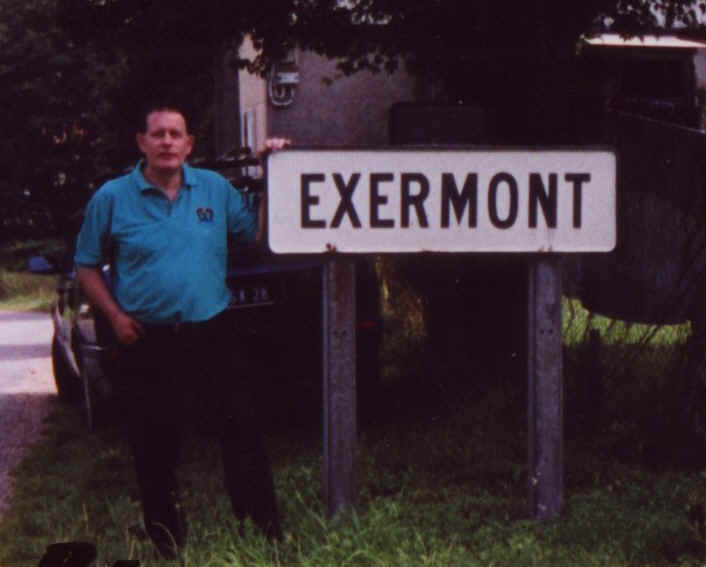
My visit the 7.8.2000. the very same village says he
can see from his foxhole 4.10.1918.
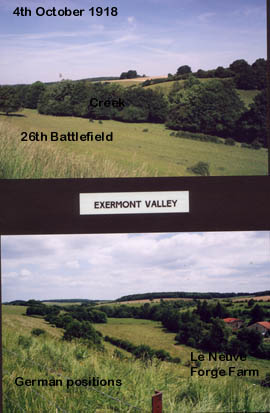
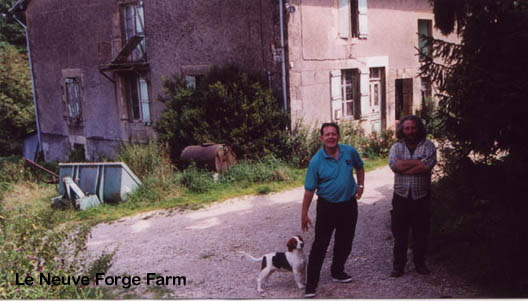
--------------------------------------------------------------------------
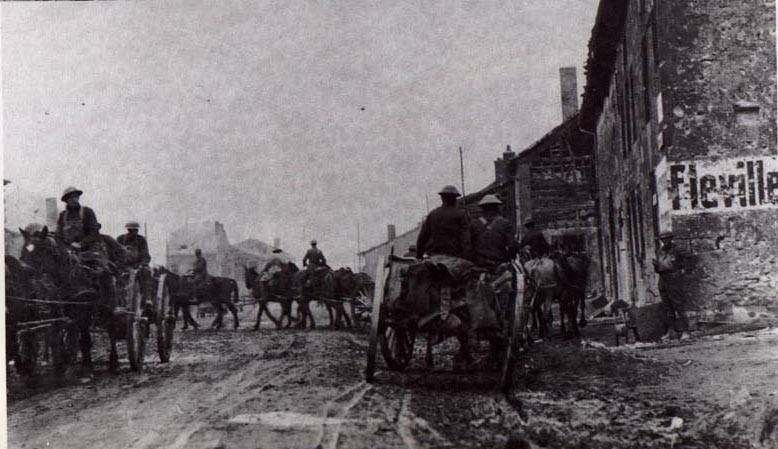
On the 4th/5th/6th June 2001 I was the guest of the Mayor of Fleville who lives in the village of Exermont , Mr Damien Georges
For my research work I was presented with a Fleville Commemorative plate
and a Medaille D'honneur for his American family in recognition of his
bravery on 4th October 1918 in Exermont Valley.

Here I am presenting Nancy King his Grand- daughter with the medal
on 10th July 2001 at Bledington, Oxfordshire before her return to
America.
I had sent my research work to his regiment in the America
this is a copy of the very nice letter I received from them.
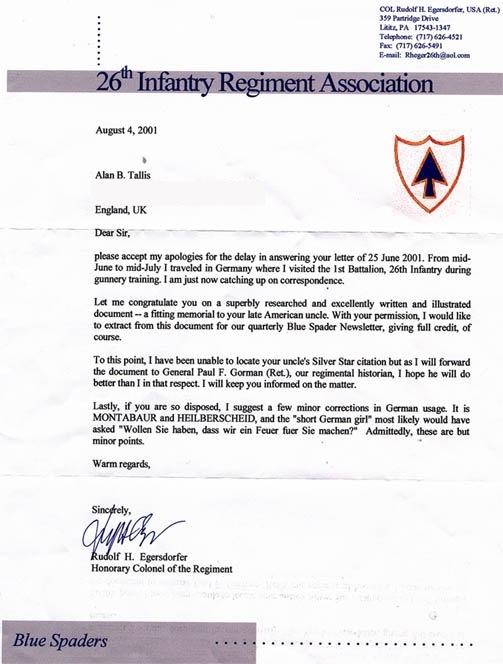
I
must thank the Colonel for all his help in finding further documentation for my
document.